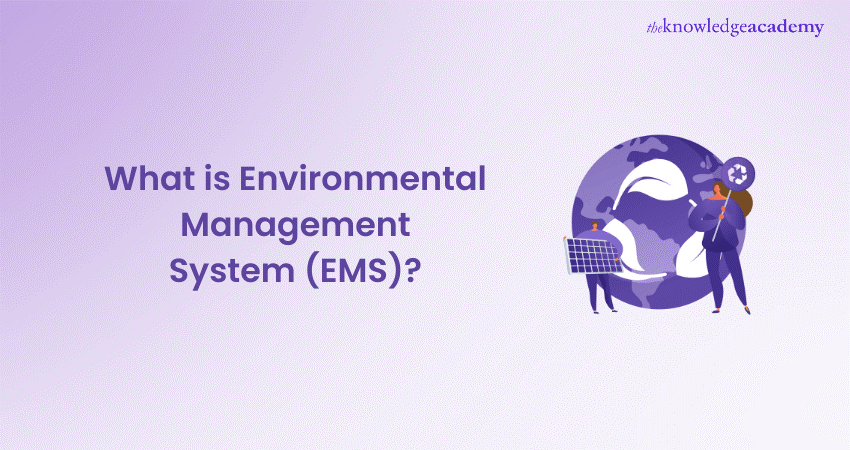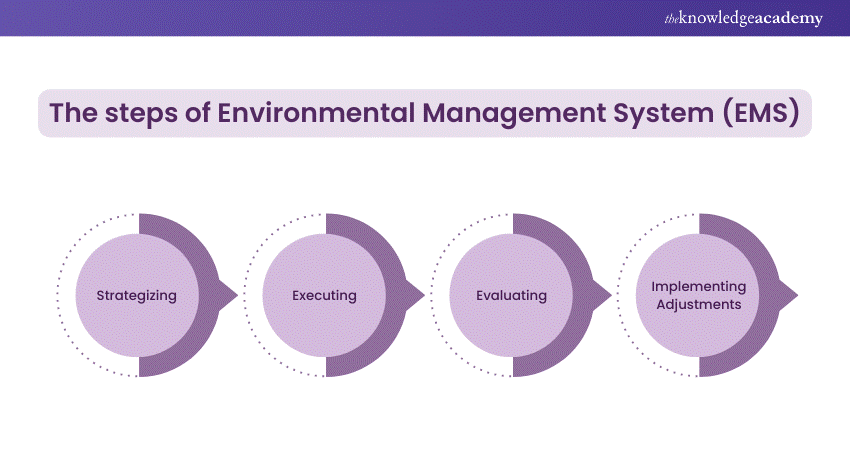We may not have the course you’re looking for. If you enquire or give us a call on +44 1344 203 999 and speak to our training experts, we may still be able to help with your training requirements.
We ensure quality, budget-alignment, and timely delivery by our expert instructors.

Central to contemporary eco-awareness is the Environmental Management System (EMS), an essential instrument for companies dedicated to making a beneficial impact on the earth. This in-depth examination provides a distinctive viewpoint on the adoption of an EMS within organisational structures as a pathway to ecological sustainability.
In this exploration, you will discover the fundamental nature of the Environmental Management System and its vital function in harmonising corporate activities with ecological preservation initiatives. It highlights the EMS’s role not just as a regulatory requirement but as a key element of conscientious environmental strategy.
Table of Contents
1) What is an Environmental Management System (EMS)?
2) Environmental Management System purpose
3) Environmental Management System types
4) Benefits of an EMS
5) How to develop an EMS?
a) Strategising
b) Executing
c) Evaluating
d) Implementing Adjustments
6) Conclusion
What is an Environmental Management System (EMS)?
An Environmental Management System (EMS) represents a methodical and organised framework that empowers your organisation to manage and enhance its ecological footprint. This blog will delve into the core principles, procedural strategies, and the pivotal importance of the EMS in elevating ongoing environmental performance.
By examining the components that form an EMS including the Environmental Aspects and Impacts Register, you will attain an in-depth insight into its operational effectiveness and its pivotal importance in fostering environmental stewardship within a corporate setting.
Environmental Management System purpose
Beyond mere adherence to legal requirements, an EMS embodies an organisation's commitment to reducing environmental footprints. You can do so by enhancing resource efficiency and achieving sustainable development goals guided by frameworks such as the ISO 14001 Life Cycle approach.
Through illustrative examples, we will explore how an EMS catalyses integrating environmental accountability into the corporate ethos, driving operational changes that benefit both the organisation and the environment.
Master environmental standards and drive sustainability with our ISO 14001 Training—Sign up now!
Environmental Management System types
Environmental Management systems (EMS) vary across organisations, each adopting a structure that best serves their ecological objectives. Here are some prevalent EMS frameworks that organisations can implement to guide their environmental initiatives:
a) ISO 14001 Standard for EMS: ISO 14001 is tailored for organisations aiming to fulfil environmental objectives. It outlines the essential components of an EMS, illustrating a cyclical process dedicated to enhancing environmental performance and ensuring ISO 14001 Compliance.
b) ISO 14001 Environmental Management System: As a member of the ISO 14000 series, ISO 14001 is among various standards that provide a holistic framework for organisations to systematically pursue environmental targets.
c) Eco-Management and Audit Scheme (EMAS): Initiated by the European Commission in 1991, EMAS is an EMS model that enables entities to oversee, evaluate, and refine their environmental strategies. Echoing the ISO 14001 ethos, EMAS promotes the ongoing advancement of an organisation’s EMS, fostering the attainment of broader ecological ambitions.
d) ISO 14005: Part of the ISO 14000 suite, ISO 14005, alongside ISO 14004, offers a flexible approach to environmental goal-setting. It permits organisations to segment their environmental objectives into smaller, manageable stages, providing adaptability to accommodate varying scenarios.
Learn how to conduct Audits for the ISO 14001 standards, with our ISO 14001 Lead Auditor Course - Sign up now!
Benefits of an EMS
EMS is necessary for your organisation if you aspire to achieve the company's environmental goals. Consequently, during the documentation and finalisation process, your organisation must allocate enough time and employee effort and might require outside consultant staff to engage.
Nevertheless, Environmental Management Systems are an expense on their own. However, they are a cost-effective approach to reducing the resources spent on the process. Apart from lowering the resource requirements, here are other benefits of implementing EMS in your organisation:
1) Enhance the overall environmental efficacy of their operations.
2) Reduce the pollutants that unsafe disposal can dump into the environment.
3) Simplify compliance with environmental regulations
4) Improves employee morale
5) It opens up your client base to customers who care about the environment.
6) Manages costs and resources
7) Creates a positive public image
8) Increases environmental awareness among employees and the company's overall
Developing an EMS

Each organisation can devise an EMS for itself. Nevertheless, most EMS companies start by inventorying their sustainability goals and Environmental Management Systems. They may also examine their country's environmental laws and requirements to ensure the EMS is inclusive.
Here is a fundamental procedural walkthrough of the steps in writing an Environmental Management System.
1) Strategising
This phase focuses on establishing a clear vision for Environmental Management, conducting environmental reviews, and setting measurable goals. Insights into strategic planning and stakeholder engagement illustrate how organisations can lay a solid foundation for their EMS.
2) Executing
Detailing the execution phase involves outlining specific action plans, resource allocation, and assigning responsibilities. Practical advice on integrating environmental objectives into daily operations and overcoming common challenges will be provided.
3) Evaluating
Evaluation mechanisms, including environmental audits and performance reviews, are critical for measuring an EMS's effectiveness. This offers methodologies for tracking progress, interpreting data, and understanding the importance of transparency in reporting with a focus on preparing for the ISO 14001 Audit.
4) Implementing Adjustments
Continuous improvement is at the heart of an EMS. It discusses how organisations can use evaluation outcomes to refine and adjust their environmental strategies, ensuring adaptability and enhancing environmental performance.
Conclusion
This manual underscores the Environmental Management System (EMS) as a crucial component of responsible business conduct, highlighting its role in the worldwide initiative to curb environmental harm. By thoroughly examining its elements, advantages, and execution tactics, this blog sheds light on the route for organisations aspiring to adopt ecological responsibility. Understanding the difference between ISO 14000 and 14001 can further guide companies in tailoring their environmental strategies. It showcases how an EMS can convert present-day environmental obstacles into the sustainable triumphs of the future.
Learn how to implement the ISO 14001, with our ISO 14001 Training -Sign up now!
Frequently Asked Questions
How does ISO 14001 differ from other EMS standards?

ISO 14001 stands out as the benchmark for EMS standards globally, offering a flexible framework that can be adapted to any organisation, regardless of size or sector. ISO 14001's unique features, including its focus on continuous improvement and integrating Environmental Management.
Are there any government incentives for implementing an EMS?

Governments worldwide often incentivise businesses to implement an EMS, recognising their contribution to environmental sustainability. Some common incentives are tax breaks, reduced regulatory oversight, and public recognition programs, demonstrating how these incentives can make EMS adopt a strategic decision for environmental stewardship.
What are the other resources and offers provided by The Knowledge Academy?

The Knowledge Academy takes global learning to new heights, offering over 3,000 online courses across 490+ locations in 190+ countries. This expansive reach ensures accessibility and convenience for learners worldwide.
Alongside our diverse Online Course Catalogue, encompassing 19 major categories, we go the extra mile by providing a plethora of free educational Online Resources like News updates, Blogs, videos, webinars, and interview questions. Tailoring learning experiences further, professionals can maximise value with customisable Course Bundles of TKA.
What is Knowledge Pass, and how does it work?

The Knowledge Academy’s Knowledge Pass, a prepaid voucher, adds another layer of flexibility, allowing course bookings over a 12-month period. Join us on a journey where education knows no bounds.
What are related Health & Safety courses and blogs provided by The Knowledge Academy?

The Knowledge Academy offers various Health & Safety Courses, including Advance First-Aid training, Active and healthy lifestyle training and Counselling Masterclass. These courses cater to different skill levels, providing comprehensive insights into What is Yoga.
Our Health & Safety blogs cover a range of topics related to Stategic Leadership, offering valuable resources, best practices, and industry insights. Whether you are a beginner or looking to advance your Project Management skills, The Knowledge Academy's diverse courses and informative blogs have you covered.
Upcoming Health & Safety Resources Batches & Dates
Date
 ISO 14001 Foundation Certification
ISO 14001 Foundation Certification
Mon 7th Apr 2025
Mon 4th Aug 2025
Mon 3rd Nov 2025






 Top Rated Course
Top Rated Course



 If you wish to make any changes to your course, please
If you wish to make any changes to your course, please


